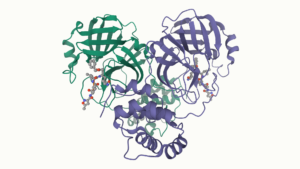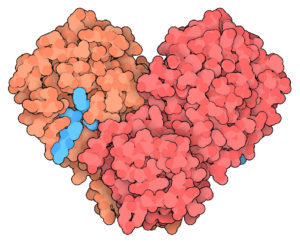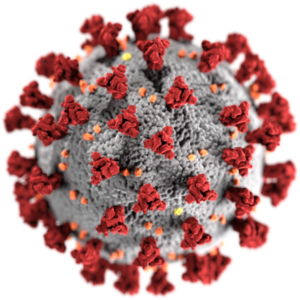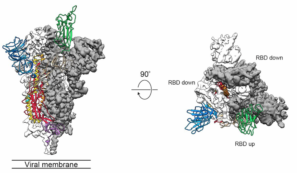First Post 3 March 2020 A terrible deathly coronavirus epidemic has gripped many countries, and its tentacles are spreading out to ever more countries. The World Health Organisation has just escalated its terminology to announce that the global risk of the outbreak spreading is "very high". This is just short of a pandemic. Perhaps by the time you read this blog, things may have worsened further and it will have really become a pandemic. We are looking to science to save us. Indeed, we are seeing unprecedented sharing of scientific information. Hopefully all stakeholders can realise that holding back information for future commercial gain may be absolutely counter productive.
What is the role here of the light source ?
The Protein Data Bank (PDB) has the main protease from the coronavirus, which causes the disease COVID 19, as its structure of the month, for February 2020. This is significant because one of the very first important steps in understanding the coronavirus and developing a vaccine, or any medical counter-measure, is to obtain structural information at the molecular level, even atomic resolution, which "helps to elucidate protein function and, in particular, the mechanisms of enzymes. This understanding inspires the design of new drugs". This quote is also a major motivation for Africa to have its own light source "Why Africa needs a Light Source".
(Images from https://www.rcsb.org/structure/6LU7 and https://pdb101.rcsb.org/motm/242).
This is a protease molecular structure obtained from X-Ray diffraction data by the team of Liu, X., Zhang, B., Jin, Z., Yang, H., Rao, Z.and it is still to be published, however its early release in the PDB can aid the search for a vaccine. Function flows from form, to some large extent, and so such information is vital to understanding the new virus. One can look for similarities to other similar protease structures from other viruses, and this can suggest treatments that may work in similar cases, or one can be inspired to develop completely new treatments.
An equally important source of structural information to X-Rays is the complementary method of Cryo-EM. This new class of electron microscope can also reconstruct near atomic scale resolution 3D images of large biomolecules. These facilities are sometimes made available at light sources using a similar access model to a regular beam line facility.
Images from Wikipedia and Science)
Above is a protein spike (right) from the coronavirus (left). This structure was obtained by Wrapp D., Wang N., Corbett K.S., Goldsmith J.A., Hsieh C-L., Abiona O., Graham B.S. and McLellan J.S. and is already published in the Science link above. The protein spike participates in the attachment and infection process as the virus approaches and interacts with human cells. Once again, an understanding of its structure and function can lead to the development of complex molecules that will inhibit its function, thereby acting as a vaccine.
These are two examples of structural studies so far, and they spawn many "educated guesses" which ultimately lead to further studies and new knowledge, then ultimately to the development of medical counter-measures. In due course, subjecting the virus to the scrutiny of science and such high precision will lead to the development of a treatment, much as it has done in so many other cases. Let's hope it can be fast.
A quick scan of some light source action and the coronavirus re-enforces the role of light sources (As at 3 March 2020):
ESRF : Structural view of coronavirus cell entry and neutralisation
APS : Trying to stop coronavirus
APS : New coronavirus protein reveals drug target
SSRF : A pan-coronavirus fusion inhibitor targeting the HR1 domain of human coronavirus spike
BSRF : Structure of Main Protease from Human Coronavirus NL63: Insights for Wide Spectrum Anti-Coronavirus Drug Design
Petra III : Structural Characterization of Human Coronavirus NL63 N Protein
===>Update : LightSources.org is now maintaining a database of the effort from Light Sources.
===>Update 7/3/2020: Light Sources seen as an ESSENTIAL SERVICE, some remaining OPEN for RESEARCH to fight the Coronavirus.
- Call from NSLS II : With this in mind, NSLS-II is offering a streamlined and expedited rapid access proposal process for groups that require beam time for structural biology projects directly related to COVID-19. The Center for Biomolecular Structure team is supporting remote macromolecular crystallography experiments at Beamlines 17-ID-1 (AMX) and 17-ID-2 (FMX) in this research area. In order to submit a macromolecular crystallography proposal for COVID-19 related research, please use the COVID-19 Rapid Access form here. For proposal questions, please contact Nancye Wright at nsls2user@bnl.gov. For scientific and/or beamline guidance, please contact Sean McSweeney at smcsweeney@bnl.gov. We also hope that policymakers and the general public can learn that we need to invest in top quality human capacity development and the establishment of significant facilities. This must be in the context of a culture of new knowledge generation for the common good, where work like this can be carried out.
===>Update 8/3/2020: Light Sources seen as an ESSENTIAL SERVICE, some remaining OPEN for RESEARCH to fight the Coronavirus.
- See also for Europe (open to the world):
===>Update 8/3/2020: To be up to date on #LightSourceScience, research on #SARSCoV2
- Sign up for a weekly update, short and essential news:http://ow.ly/Qjff50z2Wv2. The next issue is in your emailbox in less than 24hours! #sciencecontinues https://twitter.com/lightsources/status/1245612090796077061
===>Update 9/3/2020: Excellent article just appeared as the editorial of the IUCr Newsletter 2020 28/1.
===> Update 11/3/2020: Example of structure based proposal for the action of the Remdesivir antiviral drug
- The paper on the BioRXiv "structures provide critical insights into the working mechanism of viral RNA replication and a rational template for drug design to combat the viral infection".
===> Update 11/3/2020: South African work on sequencing the complete SARS-CoV-2 genome.
- This preprint describes recent work where "next-generation sequencing of pathogens can provide new insights into disease transmission and aid in drug and vaccine design".
===> Update 11/3/2020: ACE2 – A rational frontline therapy for COVID-19 summary
- See report in this blog. This is also a South African research focus area, as in this recent paper.
===>Update 19/3/2020: Brookhaven Lab Mobilizes Resources in Fight Against COVID-19
- Scientists and staff combine expertise across disciplines to address drug development, medical supplies, information processing, ..... read more
===>Update 12/5/2020: LEAPS Review - League of European Accelerator-based Photon Sciences
- Research at LEAPS facilities fighting COVID-19 : Europe’s Accelerator-Based Photon Sources join forces in fighting COVID-19, ..... read more
===>Update 10/6/2020: IUCr Cover Article
- An introduction to crystallography research on SARS-COV-2 (COVID-19) via X-ray diffraction at synchrotrons around the world, ..... read more
===>Update 26/9/2020: CERN Courier Article
- Synchrotrons on the coronavirus frontline, ..... read more
Ok ... so much is happening ... we don't record it all ..... bit here we show where to get an overview from PSI, SLS
===>Update 16/11/2021: Swiss Light Source ... a compendium of results .....
- Synchrotrons on the coronavirus frontline, ..... read more




Begin forwarded message:
From: “‘Winick, Herman’ via AfLS Steering Committee Executive”
Subject: Synchrotron light x-rays and studies of the Wuhan Virus
Date: 04 April 2020 at 21:25:06 SAST
Hi;
You may be interested to know that, although the US synchrotron light sources are shut down to prevent spread of the virus, a small crew at most or all of these facilities is keeping those beamlines operational in which crystallography studies are in progress relevant to the virus.
Best,
Herman Winick
Assistant Director and Professor (research), Emeritus
Stanford Synchrotron Radiation Lightsource Division of the
SLAC National Accelerator Laboratory (www-ssrl.slac.stanford.edu)
Professor (research), Emeritus; Applied Physics Dept, Stanford University
SSRL/SLAC MS 69; bldg 137, room 242; 2575 Sand Hill Road, Menlo Park CA
94025-7015 USA; Office Phone: (650)926-3155; Office FAX; (650)926-4100; Email;winick@slac.stanford.edu; Home Ph:(650)493-1900